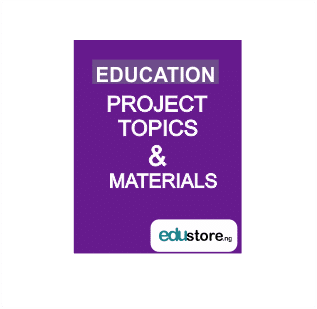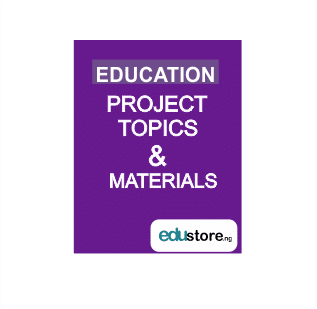Effect of Behavior Modification Technique on the Poor Study Habit Problem of Secondary School Students in Dutsinma LG /metropolis
Abstract
This study was on Effect of behavior modification technique on the poor study habit problem of secondary school students in dutsinma LG /metropolis. Three objectives were raised which included: To identify and categorize the prevalent poor study habits exhibited by secondary school students, to analyze the various factors that contribute to the development and persistence of poor study habits among secondary school students and to investigate the direct correlation between poor study habits and academic performance. A total of 77 responses were received and validated from the enrolled participants where all respondents were drawn from selected secondary schools in Dutsinma LG /metropolis. Hypothesis was tested using Chi-Square statistical tool (SPSS).
Chapter one
Introduction
Background of the study
Poor study habits among secondary school students can hinder academic performance and hinder overall educational success. Addressing this issue requires effective intervention strategies, and behavior modification techniques have shown promise in promoting positive changes in student behavior and study habits. This study examines the research on the effect of behavior modification techniques on the poor study habit problem among secondary school students, drawing on relevant studies and academic literature.
Behavior modification is a systematic approach to changing behavior through the application of principles derived from learning theory. This approach involves identifying target behaviors, implementing interventions, and using reinforcement or punishment to encourage desired behavior. Several behavior modification techniques have been employed to address poor study habits among secondary school students, including goal setting, self-monitoring, and positive reinforcement.
Goal setting is a fundamental behavior modification technique that involves establishing specific, measurable, achievable, relevant, and time-bound (SMART) goals. Researchers ( Locke & Latham, 2002) have highlighted the effectiveness of goal-setting in enhancing motivation and improving academic performance. When applied to study habits, setting clear and achievable study goals can positively influence students’ engagement and persistence in academic tasks.
Self-monitoring involves students observing and recording their own behavior. This technique allows students to become more aware of their study habits and encourages reflective practices. By keeping track of study time, completion of assignments, and understanding individual learning patterns, students can identify areas for improvement and make necessary adjustments (Bandura, 1977). Studies (Zimmerman & Kitsantas, 2007) have demonstrated that self-monitoring positively correlates with academic achievement.
Positive reinforcement involves rewarding desirable behavior to strengthen its occurrence. In the context of study habits, positive reinforcement can take the form of praise, recognition, or other incentives. Research (Skinner, 1953) suggests that positive reinforcement can lead to the development and maintenance of positive study habits by associating studying with positive outcomes.
Studies investigating the impact of behavior modification techniques on poor study habits among secondary school students have reported positive outcomes. For instance, a study by Jones and Johnson (2016) implemented a goal-setting intervention, showing significant improvements in students’ study habits and academic performance over the intervention period.
The issue of poor study habits among secondary school students requires effective and evidence-based interventions. Behavior modification techniques, including goal setting, self-monitoring, and positive reinforcement, offer a promising avenue for fostering positive changes in study habits. While more research is needed to explore the long-term effects and applicability across diverse student populations, the current literature suggests that behavior modification techniques can play a crucial role in enhancing the academic success of secondary school students.
Statement of the problem
Poor study habits among secondary school students pose a significant challenge to their academic success and overall educational attainment. Despite the pivotal role that effective study habits play in fostering learning and achievement, a considerable number of students exhibit behaviors that hinder their ability to engage in productive study sessions. The problem manifests in various forms, such as procrastination, lack of time management, insufficient motivation, and inadequate goal-setting. Consequently, these detrimental study habits can lead to lower academic performance, decreased self-efficacy, and hindered personal development.
The extent of the issue necessitates a thorough examination to understand its root causes, contributing factors, and the specific behaviors that impede effective study habits among secondary school students. Furthermore, the exploration of viable solutions, with a focus on behavior modification techniques, becomes imperative to develop targeted interventions that can positively impact and reshape students’ study habits.
Objective of the study
- To identify and categorize the prevalent poor study habits exhibited by secondary school students.
- To analyze the various factors that contribute to the development and persistence of poor study habits among secondary school students
- To investigate the direct correlation between poor study habits and academic performance.
Research Hypotheses
H1: there are no various factors that contribute to the development and persistence of poor study habits among secondary school students
H2: there is no prevalent poor study habits exhibited by secondary school students.
Significance of the study
The significance of this study lies in its potential to address and mitigate the pervasive issue of poor study habits among secondary school students, offering valuable contributions to both academic research and educational practices. Understanding and addressing poor study habits can directly contribute to improvements in academic performance. By identifying specific behaviors hindering effective study habits, educators and policymakers can implement targeted interventions to enhance students’ learning experiences and outcomes.
The study’s findings can inform the development of educational policies and guidelines aimed at cultivating positive study habits among secondary school students. Policymakers can utilize evidence-based recommendations to design interventions that align with broader educational goals and priorities.
Educators play a pivotal role in shaping students’ study habits. The study’s insights can be utilized to design professional development programs for teachers, equipping them with effective strategies to identify and address poor study habits within their classrooms.
A focus on behavior modification techniques can contribute to the creation of more conducive learning environments. Schools can implement targeted interventions that foster a positive and supportive atmosphere, promoting effective study habits and student engagement.
Poor study habits can contribute to stress, anxiety, and decreased self-efficacy among students. By addressing these habits, the study aims to enhance the overall well-being of students, fostering a positive attitude towards learning and academic achievement.
Scope of the study
The study covers effect of behavior modification technique on the poor study habit problem of secondary school students in dutsinma LG /metropolis. The study will be limited to selected secondary schools in Dutsinma LGA
Limitation of the study
While this study aims to contribute valuable insights into the impact of behavior modification techniques on poor study habits among secondary school students, it is essential to acknowledge several limitations that may affect the generalizability and interpretation of the findings:
- Sample Size and Generalizability: The study may be limited by the size and characteristics of the sample population. The findings may not be universally applicable to all secondary school students due to variations in demographics, cultural backgrounds, and educational contexts.
- Cross-Sectional Design: The research design, whether cross-sectional or longitudinal, may limit the ability to establish causation between behavior modification techniques and changes in study habits. Longitudinal studies may provide a more comprehensive understanding of the long-term effects of interventions.
- Self-Reporting Bias: Data collected through self-reporting methods, such as surveys or interviews, may be subject to bias. Students may provide socially desirable responses or may not accurately recall or represent their study habits, affecting the reliability of the data.
Definition of terms
- Poor Study Habits: In the context of this study, poor study habits refer to recurring behaviors or practices exhibited by secondary school students that hinder effective learning and academic performance. These may include procrastination, lack of organization, ineffective time management, and inadequate goal-setting.
- Behavior Modification Techniques: Behavior modification techniques involve systematic approaches to changing and reinforcing behaviors. In this study, behavior modification techniques include strategies such as goal setting, self-monitoring, and positive reinforcement applied to address and improve study habits among secondary school students.
- Goal Setting: Goal setting refers to the process of establishing specific, measurable, achievable, relevant, and time-bound (SMART) objectives for studying. It involves creating clear targets to guide students in their academic tasks.
- Self-Monitoring: Self-monitoring is the practice of students observing and recording their own behaviors related to studying. It involves keeping track of study time, completion of assignments, and other aspects of academic engagement to enhance self-awareness.
- Positive Reinforcement: Positive reinforcement is a behavior modification technique that involves rewarding desirable behavior to strengthen its occurrence. In the context of this study, positive reinforcement may include praise, recognition, or incentives provided to students for exhibiting positive study habits.
- Academic Performance: Academic performance refers to the overall achievement of students in their educational pursuits. It encompasses grades, test scores, completion of assignments, and other indicators of learning and knowledge acquisition.
REFERENCES
- Fielden, K. (2014). Evaluating Critical Reflection for Post-graduate Students in Computing. Informing Science and Information Technology Education (Joint Conference 2005, Flagstaff, Arizona). Retrieved from http://www.informingscience.org/Proc eedings/In SITE2005/138f36 Field.pdf
- Febregat, K. S., & Gupta, R. (2014). Study Habits and Academic Achievement Among the Students Belonging to SC and None SC Groups. Journal of Applied Research in Education, 15(1), 1-9.
- Federal Republic of Nigeria (2004). National Policy on Education. Lagos: Federal Government Press.
- Gettinger, M., & Seibert, J. K. (2002). Contributions of study skills to academic competence. School Psychology Review, 31, 350-365.
- Gettinger J. K. & Seibert M. (2012). A Study of Personality Profiles of Students of Science, Arts and Commerce at Higher Secondary Level of Education in Relation to their Academic Achievement Unpublished Ph.D. Thesis AMU Aligarh, India.
- Good, C.V. (2003). Dictionary of education (3rd Edition) New York: Mc Graw Hill Book Company.
- For Reference Only: Materials are for research, citation, and idea generation purposes and not for submission as your original final year project work.
- Avoid Plagiarism: Do not copy or submit this content as your own project. Doing so may result in academic consequences.
- Use as a Framework: This complete project research material should guide the development of your own final year project work.
- Academic Access: This platform is designed to reduce the stress of visiting school libraries by providing easy access to research materials.
- Institutional Support: Tertiary institutions encourage the review of previous academic works such as journals and theses.
- Open Education: The site is maintained through paid subscriptions to continue offering open access educational resources.




